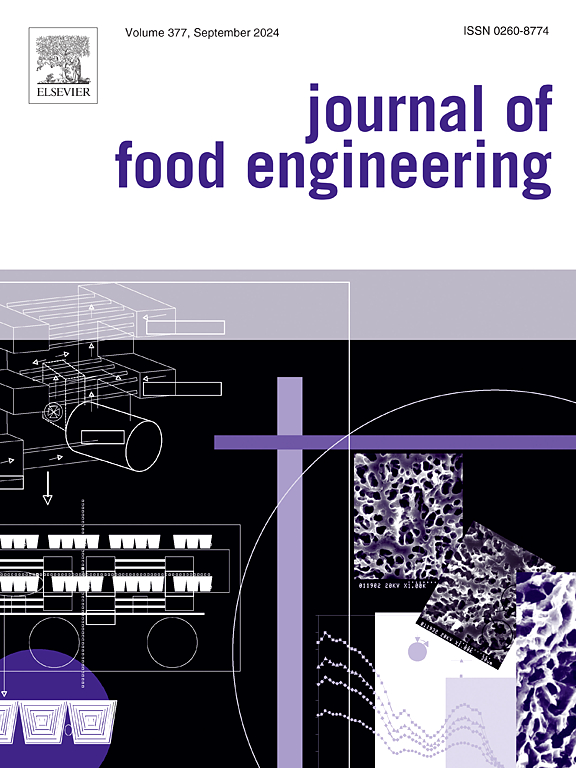Konjac glucomannan and curdlan modulate the rheological properties and digestive behaviors of oil-in-water emulsions during in vitro gastrointestinal digestion
IF 5.3
2区 农林科学
Q1 ENGINEERING, CHEMICAL
引用次数: 0
Abstract
With the rising demand for healthier food options, this study addresses the gap in understanding how the combination of konjac glucomannan (KGM) and curdlan (CUD) can enhance the stability and lipid digestion behavior of reduced-fat oil-in-water (O/W) emulsions. KGM, derived from konjac plants, and CUD, produced by Alcaligenes faecalis, are dietary fibers known for their ability to enhance food texture and rheology. Four 20 wt.% O/W emulsions with different aqueous phase compositions were prepared: (i) KGM emulsion (containing 0.8 wt.% KGM), (ii) CUD emulsion (containing 0.8 wt.% CUD) (iii) KGM-CUD emulsion (0.4 wt.% KGM and 0.4% CUD in the aqueous phase), and (iv) KGM + CUD mixed emulsion (equal volumes of individual KGM and CUD emulsions). The KGM emulsion exhibited the highest viscosity at low shear rates (0.1 s−1 - 0.2512 s−1), while the CUD emulsion showed higher viscosity at higher shear rates (0.2512 s−1 - 39.81 s−1). Among the emulsions, the KGM-CUD emulsion displayed the highest viscosity during GIT digestion, particularly under gastric conditions, and maintained a nearly constant particle size, indicating microstructural stability. Accordingly, free fatty acids (FFAs) released (%) at the end of intestinal digestion followed the order: KGM (63.55%) > KGM + CUD (42.43%) > KGM-CUD (40.85%) > CUD (36.30%). This study highlights the potential of KGM-CUD mixtures to modulate the digestion of lipid emulsions, offering valuable insights for the development of healthier food products with reduced lipid digestibility.
魔芋葡甘露聚糖和凝乳素对水包油乳剂体外胃肠道消化的流变特性和消化行为的调节作用
随着人们对健康食品的需求不断增加,这项研究填补了人们在了解魔芋葡甘聚糖(KGM)和凝胶(CUD)的组合如何增强减脂水包油(O/W)乳剂的稳定性和脂质消化行为方面的空白。从魔芋植物中提取的 KGM 和从粪藻菌中提取的 CUD 都是膳食纤维,因其能够增强食品质地和流变性而闻名。我们制备了四种不同水相组成的 20 wt.% 水包油型乳液:(i) KGM 乳液(含 0.8 wt.% KGM),(ii) CUD 乳液(含 0.8 wt.% CUD),(iii) KGM-CUD 乳液(水相中含 0.4 wt.% KGM 和 0.4% CUD),以及 (iv) KGM + CUD 混合乳液(等体积的单独 KGM 和 CUD 乳液)。KGM 乳化液在低剪切速率(0.1 s-1 - 0.2512 s-1)下粘度最高,而 CUD 乳化液在较高剪切速率(0.2512 s-1 - 39.81 s-1)下粘度较高。在这些乳液中,KGM-CUD 乳液在胃肠道消化过程中,尤其是在胃条件下,显示出最高的粘度,并且保持了几乎恒定的粒度,表明微观结构稳定。因此,肠道消化结束时释放的游离脂肪酸(FFAs)(%)依次为KGM(63.55%);KGM + CUD(42.43%);KGM-CUD(40.85%);CUD(36.30%)。这项研究强调了 KGM-CUD 混合物调节脂质乳剂消化的潜力,为开发脂质消化率更低的健康食品提供了有价值的见解。
本文章由计算机程序翻译,如有差异,请以英文原文为准。
求助全文
约1分钟内获得全文
求助全文
来源期刊

Journal of Food Engineering
工程技术-工程:化工
CiteScore
11.80
自引率
5.50%
发文量
275
审稿时长
24 days
期刊介绍:
The journal publishes original research and review papers on any subject at the interface between food and engineering, particularly those of relevance to industry, including:
Engineering properties of foods, food physics and physical chemistry; processing, measurement, control, packaging, storage and distribution; engineering aspects of the design and production of novel foods and of food service and catering; design and operation of food processes, plant and equipment; economics of food engineering, including the economics of alternative processes.
Accounts of food engineering achievements are of particular value.
 求助内容:
求助内容: 应助结果提醒方式:
应助结果提醒方式:


